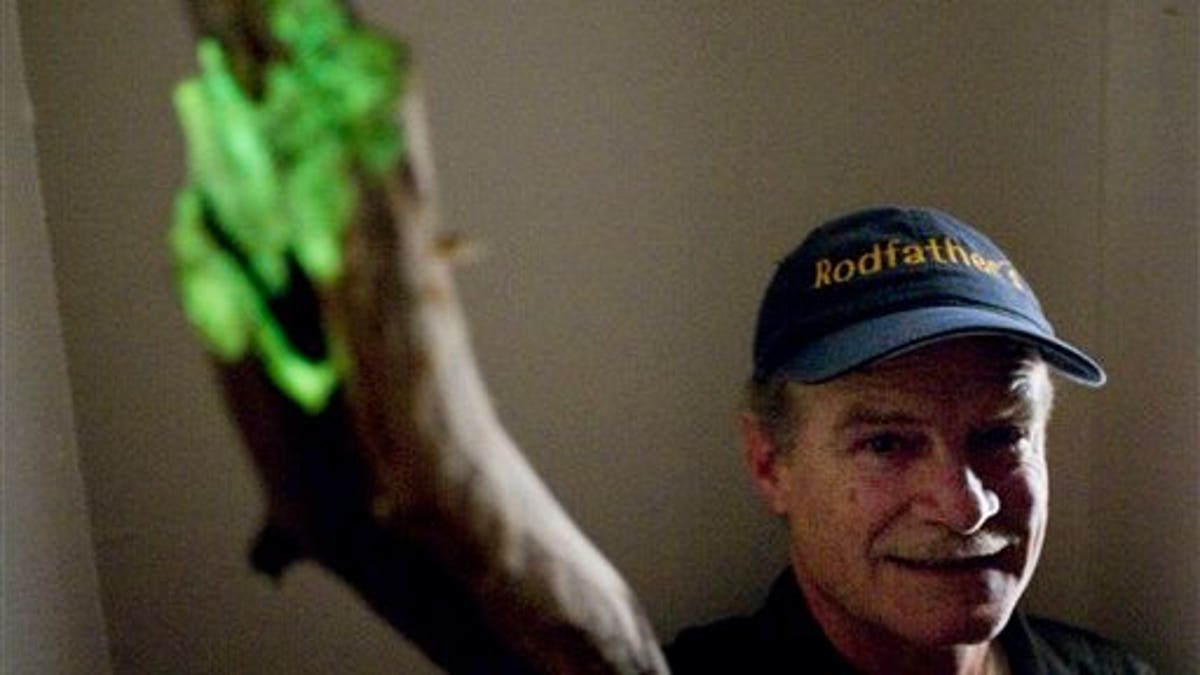
April 6: Samuel Holes, 52, displays his glowing stick in a dark closet during a four second exposure at the Juno House in Juneau, Alaska. Holes found the stick while searching for firewood on a recent camping trip near the base of Thunder Mountain. (AP)
JUNEAU, Alaska -- It looks like any stick that has spent years in a rain-soaked, mold-ridden ecoclimate. The exterior is decrepit and dingy, its heft like a few handfuls of sand. Its insides smell rich of alder and sour milk. But this seemingly ordinary piece of wood, one that would likely end up in a wood pile rather than a news story, boasts one baffling characteristic: it glows.
"I was just amazed. I'd never seen anything like it in my life," said Juneau resident Samuel Holes. "I looked down and it was glowing, in the dark, I couldn't believe it."
A dwindling camp fire, a dark night and a little bit of luck drew Holes' eyes in the direction of what he thought was only a reflection several nights ago while camping near the base of Thunder Mountain.
He looked harder, deciding it was no reflection. Holes bent down and picked up the pieces of splintered wood. They continued to glow neon green in his hand. That's when he saw it; the round end of a 4 1/2-foot stick. And the inside, the core, echoed forth the same eerie gleam.
"I thought, I'm gonna keep it," he said.
And so he did.
While the description of such a finding raises eyebrows, draws a fare amount of scrutiny and a whole lot of disbelief, there's one local professional who wasn't so shocked.
"Turns out, it's not surprising," said Paul Hennon, a forest pathologist with the U.S. Forest Service.
"I heard a similar story about four or five years ago," he said. "A friend in Sitka called me up saying someone came into his office saying their pile of firewood was glowing. He went out to take a look, and sure enough, it was."
Hennon works locally studying tree diseases and wood decay.
The green glow is called bioluminescence, he said. Basically, it's energy released by a fungus working to decompose the wood. There are a few types of locally residing fungi that release energy in the form of phosphorous, which in turn causes the material to radiate a greenish color -- the same limey glow that Holes saw in his stick.
The fungus, which Hennon said is likely from the genus Armillaria, prefers spruce and hemlock, but has also been found in alder. Their role is to recycle carbon and dead plant parts, he said.
"It's not unlike the same biochemical process that you see in the water," Hennon said.
He's referring to bioluminescence, an occurrence seen in ocean waters within microscopic marine plankton, and in a nutshell, appears as a defense mechanism when they are disturbed.
Hennon said the stick Holes found is likely in the early stages of decay, though to the average person it looks healthy and freshly cut.
"There are different stages of decay," he said. "It may be partially decomposed, though it may not look that way yet. (The fungi) start growing through the wood without causing it to look differently."
Regardless of what plans the fungi have for this stick, Holes said he's going to hang on to his new souvenir.
"This is a one-in-a-million find for me," he said. "I've been in the woods camping for many, many years and I'm just so surprised to find something like this."
"I've been around for 52 years and I couldn't fathom a piece of wood glowing in the dark. But that's just what it was doing."

